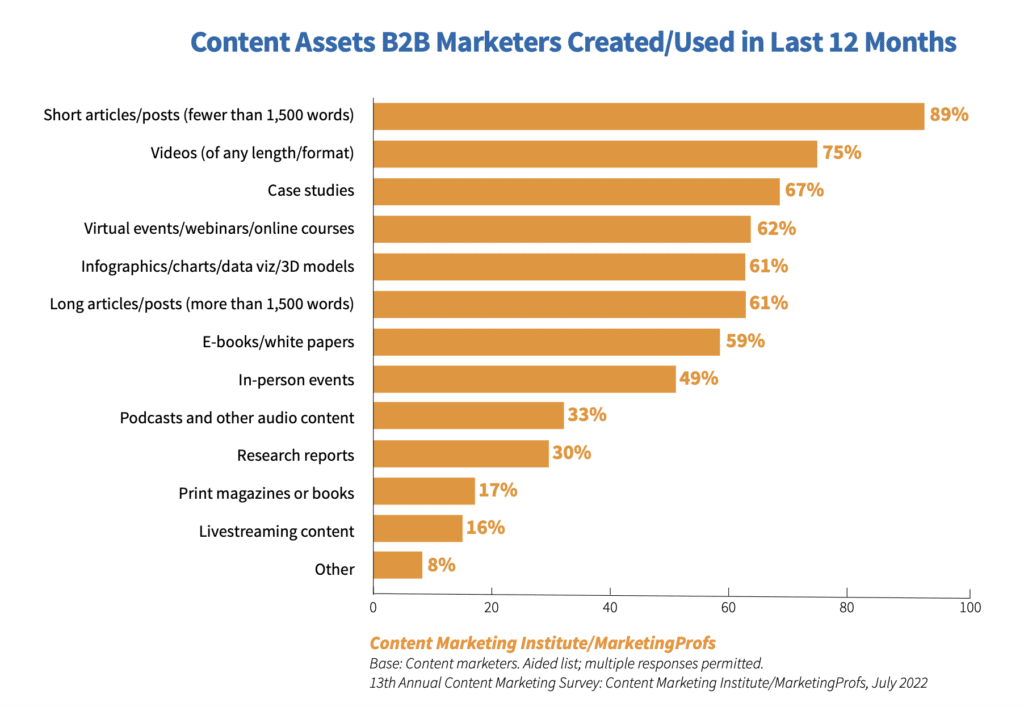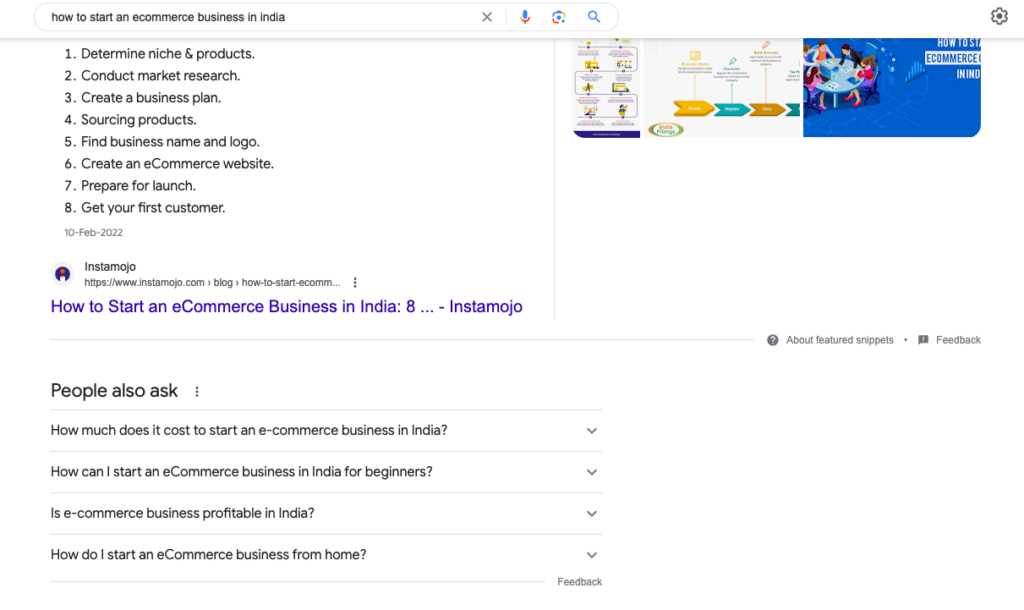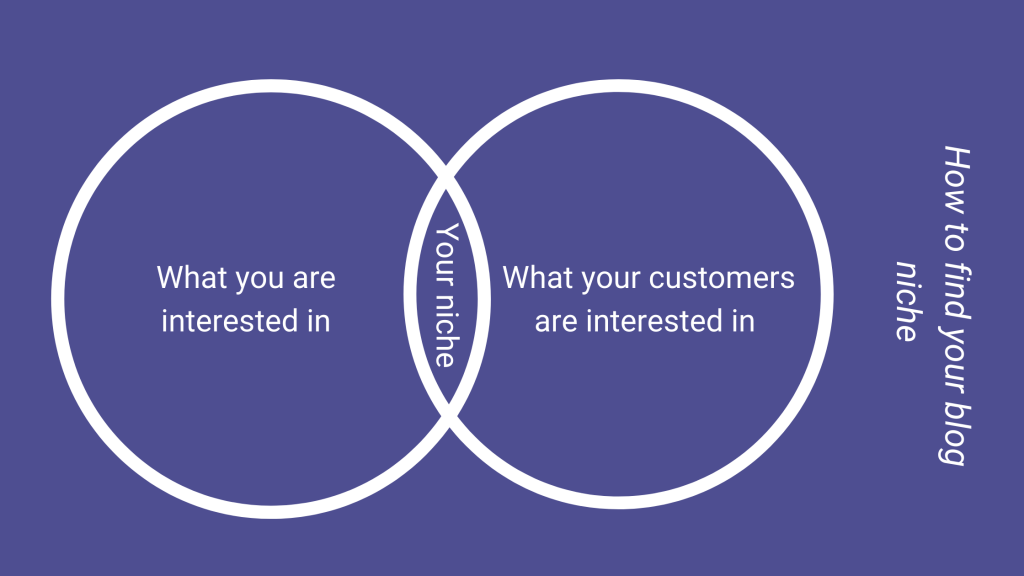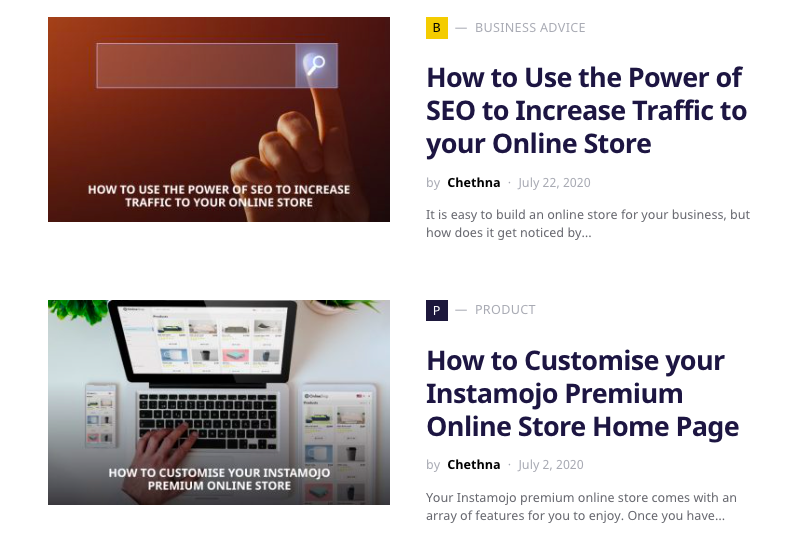Did you know that the sentence you are currently reading is the most important part of your small business blog? When you start blogging for your small business, you need to spend time preparing a strategy with one goal in mind; to sell your brand!
So why do you need a blog at all? Let us tell you why.
You are here, reading this article hoping it serves you a purpose – helping you start a blog! The heading says so, and so does the body of the blog.
That’s step one.
In this blog, we will cover:
- Why do you need a blog for your small business?
- How to set up a blog – 5 key tips to keep in mind
- How to get traffic to your small business blog
Why do you need a blog for your small business?
According to a SEMRush post, blogs are still the most popular form of content marketing out there.
Why? It brings in the most organic traffic to small business websites and leads customers further down the marketing funnel.
If you see the following infographic, you’ll notice – articles of 1500 words are used the most in content marketing by businesses in 2023.

You need to have a blog for your small business to provide resources for your readers.
How do you start a blog for your small business?
Before you set up a blog, make sure you have answered the following questions:
- Who is your target audience?
- What are the most common FAQs or queries you receive from your loyal customers?
- Do you want to provide through blogs – education, tips, or simply product information?
What we did: When we began writing blogs at Instamojo, it kickstarted as an experiment. We spoke about our events, and products and slowly, as the audience grew and our traffic to the blog increased, we began to explore other forms of blog content and separate them into different categories for each audience base.
Once you clearly define what you wish to inform your readers about, do a little research. Start with a content marketing strategy that works best for your brand. Let’s explore that further in the next section.
How to set up a blog – 5 key tips to keep in mind
What is your content strategy for your brand? This short and easy video tutorial will help you draw a simple content plan that keeps in mind –
- Your target audience
- A niche that suits your topic in mind
- A content calendar or software that tracks your blog topic
First, choose a platform to write the blog
You will need to use a Content management system to publish your blogs for the world to see. If your business has an active online presence, set up a WordPress account.
Choose a theme that suits your brand and start publishing. But before you hit publish, ensure you have taken care of a few basic blog content rules.
Second, learn a little SEO
SEO (Search Engine Optimisation) is one of the first things every content marketer needs to learn when they start blogging for their small business.
In our experience, optimising our blog content for SEO did not just help with traffic, but also brought about a sense of discipline in the content.
WordPress offers plugins to help your content with SEO. You can also use tools like SEMRush or Moz to check how SEO helps your blog traffic. Here is our guide for beginners to help with optimising your content for search engines.
The key elements you need to watch out for are:
- Keywords. Find out what keywords are trending through Google Keywords Tool to rank your blog higher on search engines
- Anchor text and hyperlinks: TO increase traffic juice and discoverability, read up on anchor texts and add links to internal and external sources. For example, in this blog alone, you will notice words that have hyperlinks to other articles. That’s SEO for your blog.
- Meta descriptions and Alt Tags: What is your primary keyword? Is it being used in your meta description? Ensure you also add relevant H1, H2 and H3 tags for your blog content. This helps your blog get ranked in the People Also Ask section in Google, which looks like this –

Related read: 3 keyword strategies to improve your online store SEO
Step 3- Write, edit, rewrite
Use short, crisp sentences, even if your blog body is extensive. Explain your content in a manner that can be understood by your mother. This is in fact, a relevant tactic used by Ann Headley, a Content Marketing expert.
Your blog content should be straightforward to understand for the reader, so once your first draft is ready, take a break and come back to edit and rewrite it. Break it down into H2 and H3 tags, and add visual aids like videos and images.
Keep your blog simple and fun for your readers. This alone will help your bounce rate.
Step 4 – Get feedback from your audience
Blogging for your small business should be primarily for your reader base.
Add CTAs to your blogs and encourage your customers and readers to provide you with consistent feedback on the topics that you write. Audiences can also help you with blog ideas.
For example, an increasing number of online businesses in our community requested us to help them set up an online store with a guide, so we delivered.
We spent days working with the product and store team to understand an easy way to set up an online store for sellers. Post that, we published our blog and our audience found it useful.
Lastly, keep a content guideline document
Once you write blogs regularly, it is best to keep a document that mentions all the content guidelines; right from grammar to abbreviations. Follow an AP style guide for copy and keep your language and tone consistent for your readers to have an optimum blog experience.
Your content guideline document can be simple and straightforward. Make sure it is accessible to everyone contributing to blogs for your business.
Maintain a repository of blog ideas, along with deadlines and author assigned. Not all blogs can be written in a day, so do try and keep realistic deadlines based on topic and research time.
Related read: 10 powerful marketing tools & features you can find on the Instamojo dashboard
How to get traffic to your small business blog
You wrote a blog on a relevant topic. Now, however, you need to distribute your content to gain traffic to your website or online store.
This is how you grow your blog and expand your content marketing base.
Start with social media
Share your blogs across different social media channels based on peak visitor time. Add relevant hashtags and social copy to attract your readers. You can choose to share different blogs on different channels based on your social marketing goals
For example, we wrote a blog on Barbenheimer fever! WE broke down the blog into a thread to make it easier to consume, this is the last tweet that has a relveent CTA.
Read the entire blog here for major takeaways from #BarbieTheMovie and #OppenheimerFilm‘s marketing – https://t.co/iaChBzOhsw
— instamojo (@instamojo) July 21, 2023
Send it to your email base
Share your blogs via newsletters, add blog links to product emailers and launch announcements. These blogs could be any topic relevant to your products or services.
Share weekly tips, hacks, and business ideas with your customers via email. We have one too. You can subscribe to our weekly blog digest here and scout ideas for your business.
Share it with your online community
Saw an interesting comment thread about your brand’s services. Share your blog links!
Send new blog links to your online community base and chat with your customers about them. This helps maintain a steady feedback flow and you get new ideas for your blog.
If you need to find a little inspiration to write your first blog, take a look at ours. Let us know your thoughts and do share your blogs with us too!




3 comments
This article is very informative, especially for us business owners! Keep sharing!
Hey, this is very informative. Just wanted to ask what options, other than WordPress, are available?
Hi
You can also opt for Wix, Medium, Squarespace or Quora if you wish to start somewhere.